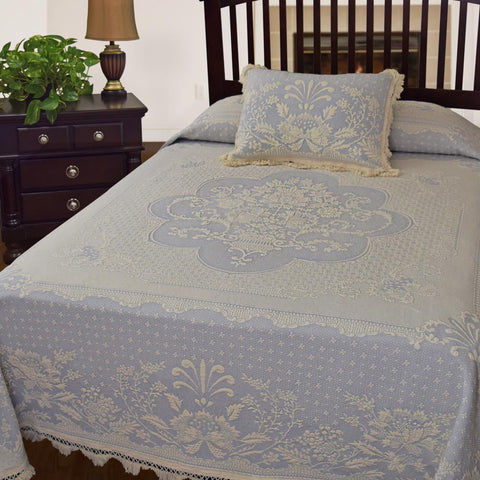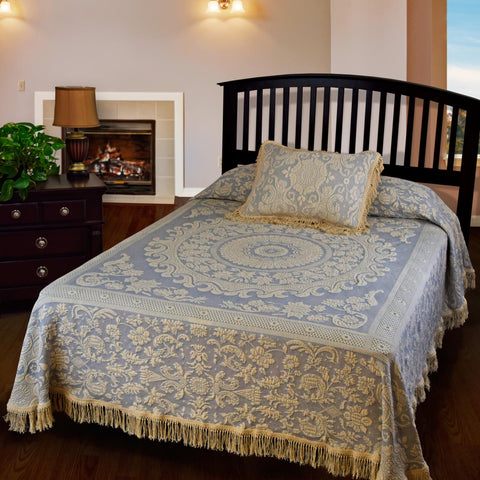Matelasse Weaving on Our New Jacquard Loom
If you follow us on social media or keep up with our blog, you may be aware that last fall we installed a brand new matelasse loom in our manufacturing facility (and if you haven't read about that yet, you can check out the post here).
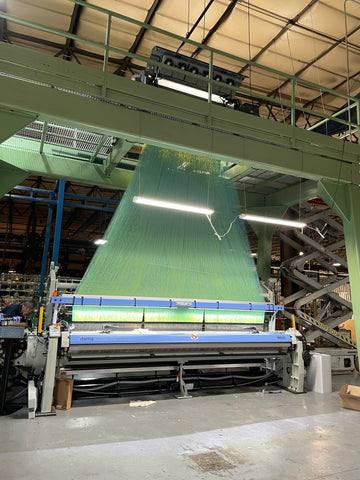
We've been running it for a few months now, and it has truly been an incredible addition to our production floor. This new loom allows us to weave material for our matelasse bedspreads 2x faster than our older jacquard looms!
In this blog article, we'll be taking you through the process of making a matelasse bedspread with material woven on our brand new loom. But first, let's brush up on what the term "matelasse" refers to.
Pictured above: Abigail Adams Matelasse Bedspread
Matelasse is a figured, woven fabric that has a history beginning in 1700’s France. This popular fabric was originally hand quilted, which made it incredibly luxurious. In the early 1740's, England found a way to reproduce a similar material on a loom. This innovation allowed the coveted material to become commercially available by the 1760’s. With the advent of the Jacquard loom in 1801 in France, producing the woven "quilting" became even faster. France, wanting to maintain the identity of their hand-quilting, began using the name "matlasser," meaning "to quilt" in French. This is where the modern term "matelassé" comes from.
Pictured above: Queen Elizabeth Matelasse Bedspread
So how do we turn the matelasse fabric coming off our new loom into a bedspread (or pillow sham, or throw)? Keep reading to find out!
1| Weaving
First, the material has to be woven on the new loom. As the loom weaves, fabric accumulates on a roll on the front of the loom. A finished roll of fabric is pictured here, ready to be taken to cutting.

2| Cutting

Rolls of woven material are taken to our large cutting table to be cut to the perfect dimensions. Here is a stack of our Americana Matelasse Bedspreads that have been cut and stacked neatly on an organizational trolly. After fabric has been cut, it’s ready to be stitched.
3| Stitching
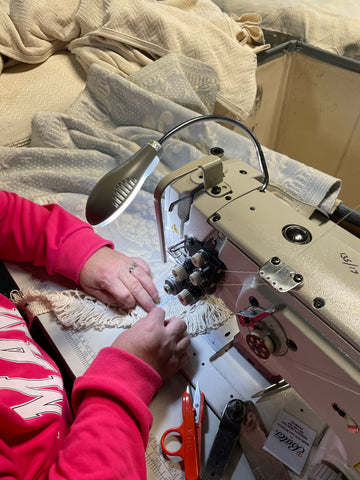
Stitching involves putting hems and/or fringe onto the finished product, depending on what is being created. Our matelasse bedspreads, throws, and matching pillow shams have fringe added. In this photo one of our stitchers is putting fringe on an Abigail Adams Pillow Sham.
4| Washing
After stitching, items are taken to our washroom where they will be wet finished. “Wet finishing” is just a fancy term for getting washed and dried. It may seem simple, but this is actually a vital part of the process. Washing fluffs the raw cotton fibers, which gives our matelasse fabric its characteristic quilted look.

5| Inspection
Once washed, our finished matelasse products are taken to the inspection tables. Here, our inspection team carefully looks over every bedspread, throw, and sham, clipping stray threads and looking for any possible defects. Products are also packaged here before they are shipped out to customers.
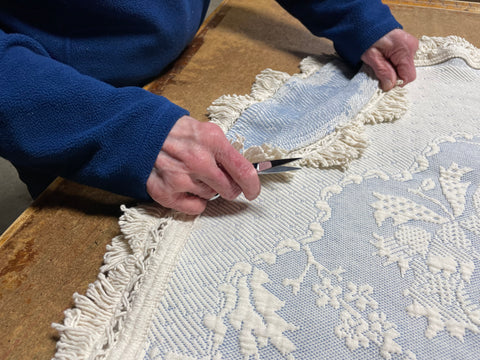
(Side note: sometimes our inspection team does find minor defects in a bedspread. We offer these products for sale at greatly reduced prices, so be sure to sign up for our newsletter to be notified about our next Seconds Sale!).
Do you have questions about our new loom, matelasse products, or manufacturing process? We’d love to hear from you. Ask in the comment section below!

